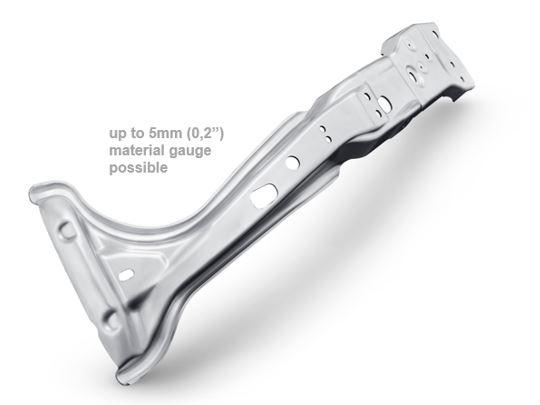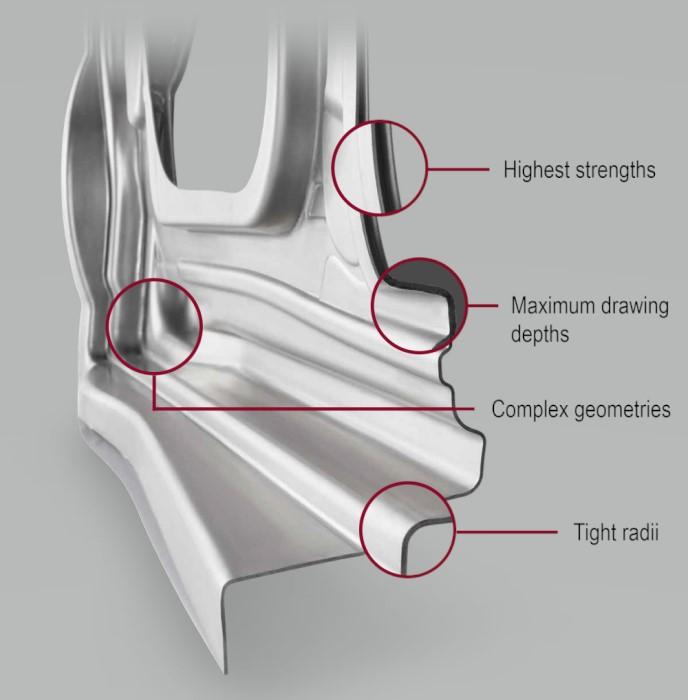Contributing editor
- FMA
- The Fabricator
- FABTECH
- Canadian Metalworking
Categories
- Additive Manufacturing
- Aluminum Welding
- Arc Welding
- Assembly and Joining
- Automation and Robotics
- Bending and Forming
- Consumables
- Cutting and Weld Prep
- Electric Vehicles
- En Español
- Finishing
- Hydroforming
- Laser Cutting
- Laser Welding
- Machining
- Manufacturing Software
- Materials Handling
- Metals/Materials
- Oxyfuel Cutting
- Plasma Cutting
- Power Tools
- Punching and Other Holemaking
- Roll Forming
- Safety
- Sawing
- Shearing
- Shop Management
- Testing and Measuring
- Tube and Pipe Fabrication
- Tube and Pipe Production
- Waterjet Cutting
Industry Directory
Webcasts
Podcasts
FAB 40
Advertise
Subscribe
Account Login
Search
Exhaust supplier merges into new lane as hot stamper
Stainless tube supplier replaces loss of exhaust demand with stampings
- By Kate Bachman
- August 5, 2022
- Article
- Metals/Materials

The fischer group is a global tier supplier of stainless steel tube, with 2,500 employees all over the world and annual sales of 650 million euro. In 2019, the manufacturer initiated a stunning transformation: It began hot stamping EV components. Images: fischer group
The fischer group is a global tier supplier of stainless steel tube, with 2,500 employees all over the world and annual sales of 650 million euro. In 2019, the manufacturer initiated a stunning transformation.
As a tube mill and tube fabricator, one of its major markets and revenue sources has been components for automotive exhaust systems. The family business management assessed the future of automotive and determined that exhaust systems eventually would be phased out with the emergence of electric vehicles.
As a result of that assessment, the company searched for other opportunities to replace its major revenue source and made a large leap. The tube maker became a stamper of hot-formed, high-strength aluminum components for lightweighting in electric vehicles and other vehicles. It had never performed this type of stamping before.
Evaluation Leads to Change
Marc Schweizer, business development manager for fischer group, explained.
“Our stainless steel tubing is really strongly related to the combustion engine—exhaust systems, exhaust converters, oil tubing, water tubing … all the tube that you need for the safe function of the combustion engine.” Fischer also performs some tube fabrication.
“Since times are changing now and all the new electric vehicles are popping up everywhere, the management was looking for a couple of years for new businesses. We still have a stronghold in stainless steel pipe for the chemical and food industries, but the automotive exhaust tubing business is not growing any further in the future. It's mostly getting smaller in the long run,” Schweizer said.
The Hot Stamping Press, Process
The manufacturer installed an AP&T fully automated hot stamping line in its Achern, Germany headquarters. The process enables the forming of complex components from very hard, high-strength 6000- and 7000-grade aluminum. In addition, hot forming car body parts out of high-strength aluminum can result in weight savings of up to 40%, according to AP&T.
The centerpiece of the system is AP&T's servo-hydraulic press, which enables high-precision forming control throughout the press cycle. The servo-hydraulic press is also considerably more energy efficient than a conventional hydraulic press, according to AP&T. The system included:
- Destacker.
- Marking station.
- Furnace feeder.
- High-performance, multilayer convection furnace.
- Water-cooled forming and quenching tools.
- Servo-hydraulic press with integrated lubrication system for tools.
- Transfer automation for press loading/unloading.
- Aging furnaces.
The process comprises four steps, Schweizer said.
First, the aluminum blanks are heated to get the material solutionized. Then the hot blank is moved quickly to the press, where it is pressed and then quenched. Quenching is critical for the final part quality. Next, the blank is moved to the aging area where the part its aged in a kind of baking process. The fourth and final step is laser trimming the part trim outline.
In an additional process, a partner cleans and coats the parts for final assembly.
Steep Training Curve
Fischer had purchased a hydroforming system from AP&T in the past, and had a trusted relationship with them. Because the hot forming process was new to fischer, AP&T provided extensive training for the staff, even training personnel on-site at AP&T’s facility in Sweden for an extended period of time.
“Moving to this process was quite a task because the thermal processing is different than cold tube forming. The hot thermal process was very new to us. It's not more complicated, but it's different. You have to look at things differently,” Schweizer said.
“In hot forming, you have four major temperature-related manufacturing processes—solution heat treatment, heating, quenching, and aging. You have to keep and tune the temperature quite exactly to receive good quality. You have to hit the temperature. You have to be really precise on timing, which means you have to keep particular parts’ time in the open position exactly, but not longer, not shorter. You have to track all parts. You have to measure the parts differently.”
This required extensive training for the team. “It was also quite an interesting story since we didn't have a line available to train on. This was all happening during the pandemic,” Schweizer said. Because Germany’s COVID-19 restrictions were tighter than Sweden’s, having the AP&T trainers travel to Germany or having the employees commute back and forth to Sweden would be difficult, if not impossible. In addition, the client, a prominent startup automaker, had time pressures that were transferred to fischer.
“We decided to move our core team of about 15 employees to the AP&T facilities in Sweden.” They worked there for about four months straight to get fully trained. It turned out to be the optimal arrangement to get the staff up to speed as quickly as possible, he said, even though travel and lodging costs were quite expensive for the company and being away from family during that time was difficult for employees.
“It was a really steep training curve. I think this would not have been possible with occasional training, phone calls, and video conferencing. In the end, it was the best decision fischer could have made to meet the needs of the customer.”
The whole installation and training was completed in less than a year.
Today, Fischer is hot stamping body structural parts, side panels, and battery protection—10 different SKUs altogether. Schweizer estimates that the manufacturer is on track to form between 300,000 and 400,000 hot-stamped, high-strength aluminum parts per year.
“And the quality of the current part is looking really good.”

Hot forming car body parts, such as this B pillar, out of high-strength aluminum can result in weight savings of up to 40%.
Seismic Shift Secures the Company’s Future
The 50-year-old, family-owned business is in its second generation. The founder, Hans Fischer, has been succeeded by his two sons, Roland and Hans Peter, who is CEO. Fischer has facilities all over the world—in Germany, Canada, China, South Africa, Austria, Mexico, Uruguay, and the U.S.
The expansion to include hot stamping in its capabilities has been a major step for the company, Schweizer said.
“It's really huge. I would say it is one of the biggest changes in the history of the company.” Having secured a prominent startup automaker as its first customer was pivotal in the investment decision. “This made it much easier to invest in the new technology … to open the checkbook to get this moving.”
The sizable capital equipment investment may have a long ROI, but it’s important to family management to make sound decisions on the company’s direction to ensure its future.
“Since it's a family business, our company management is really thinking about a long time span. They want to grow the company for the next generation. They don't look for short profits; they look to have a safe company. And so the decision was quite clear. You have to take action. You need to find other businesses to have a secure future,” Schweizer said.
About the Author

Kate Bachman
815-381-1302
Kate Bachman is a contributing editor for The FABRICATOR editor. Bachman has more than 20 years of experience as a writer and editor in the manufacturing and other industries.
Related Companies
subscribe now

The Fabricator is North America's leading magazine for the metal forming and fabricating industry. The magazine delivers the news, technical articles, and case histories that enable fabricators to do their jobs more efficiently. The Fabricator has served the industry since 1970.
start your free subscription- Stay connected from anywhere

Easily access valuable industry resources now with full access to the digital edition of The Fabricator.

Easily access valuable industry resources now with full access to the digital edition of The Welder.

Easily access valuable industry resources now with full access to the digital edition of The Tube and Pipe Journal.
- Podcasting
- Podcast:
- The Fabricator Podcast
- Published:
- 04/16/2024
- Running Time:
- 63:29
In this episode of The Fabricator Podcast, Caleb Chamberlain, co-founder and CEO of OSH Cut, discusses his company’s...
- Trending Articles
Capturing, recording equipment inspection data for FMEA

Tips for creating sheet metal tubes with perforations

Are two heads better than one in fiber laser cutting?

Supporting the metal fabricating industry through FMA

Omco Solar opens second Alabama manufacturing facility

- Industry Events
16th Annual Safety Conference
- April 30 - May 1, 2024
- Elgin,
Pipe and Tube Conference
- May 21 - 22, 2024
- Omaha, NE
World-Class Roll Forming Workshop
- June 5 - 6, 2024
- Louisville, KY
Advanced Laser Application Workshop
- June 25 - 27, 2024
- Novi, MI




























